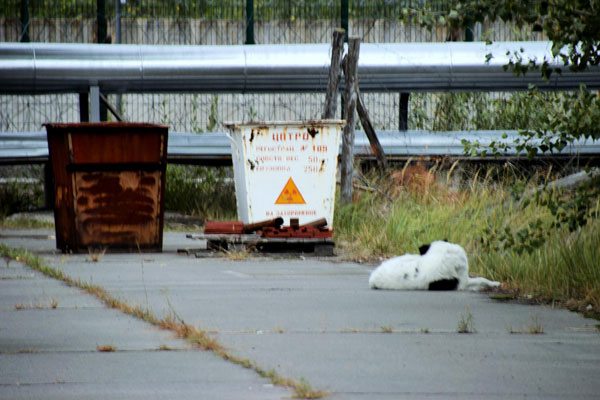
February 5, 2018; The Guardian
There are easier places to organize a canine spay/neuter clinic than at the site of the world’s worst nuclear disaster, but don’t tell Lucas Hixson and Erik Kambarian. The pair have taken up the mission of caring for the dogs living in the shadow of the Unit 4 reactor at the Chernobyl Power Plant in Ukraine and in the thousand-square-mile exclusion zone around it. The dogs are primarily the descendants of household pets left behind in the mandatory evacuation as the 1986 disaster unfolded.
A dog was one of the last things Hixson expected to see when stepping off a train in the exclusion zone at Chernobyl and getting his first view of the contamination unit being built by an international team around the Unit 4 reactor. Hixson and Kambarian formed the Clean Futures Fund to support communities affected by industrial accidents and were there for a vocational training. The duo was shocked to discover the large population of stray dogs, around 250 of them, living in and around the power plant, with hundreds more were living in the woods around the plant.
Over 20 years ago, during the initial evacuation of 120,000 people from 189 cities, many of the residents assumed they would be allowed to return shortly and were ordered not to bring their pets. They were never allowed to return to some of the areas, and the military later returned to carry out an ordered cull of all wildlife, pets, and farm animals around the plant.
ChNPP today is not the ghost town many imagine it to be. Instead, it is a daily bustling worksite for over 2,000 men and women. Some of the pets apparently survived the cull and started migrating towards the power plant, where workers were on-site after the accident, working to build the sarcophagus constructed around reactor 4 immediately following the accident. Hixson even has pictures of workers holding puppies in the weeks following the accidents.
Sign up for our free newsletters
Subscribe to NPQ's newsletters to have our top stories delivered directly to your inbox.
By signing up, you agree to our privacy policy and terms of use, and to receive messages from NPQ and our partners.
The stray dogs, and a few felines, are totally reliant on the workers for any care they receive. As their fur could contain nuclear contamination, they cannot leave the exclusion zone at this time. There is also the risk of rabies, brought by predators like wolves that moved into the woods scattered throughout the exclusion zone. Rabies vaccines for humans, which would need to be obtained through Russia, have been increasingly tough to procure the last five years.
Out of desperation, and with a lack of funding or plans to control the stray dog population in a humane manner, workers were ordered by the construction company to kill the dogs. They have so far refused, but the workers also had few options to care for the dogs other than to share lunches and help shelter sick puppies from the elements, like the harsh Ukraine winters.
Upon seeing the problem, Hixson and Kambarian immediately began to form a plan to ensure the stabilization of the stray dog population and provide for their long-term care. The three-year plan to care for the dogs of Chernobyl includes multi-year spay/neuter clinics, vaccinations, and, when funding eventually allows, an onsite veterinarian. (They have raised over $50,000 so far.) Hixson notes that the Chernobyl dogs appear to have a shorter lifecycle than your average household dog; all the dogs at the plant look to be under 6 years of age. This means the population could contract fast with efforts to spay and neuter.
The Clean Futures Fund treated over 200 dogs during a fall 2017 trip, and the team is eager to see what effect their efforts have had on the population when they return this summer. Looking back on the journey thus far, Hixson comments, “I knew I wanted to do something right away, I don’t think I could’ve ever foreseen how much we are able to do however. The final reality has been shaped over time, based on our desire to do the most humane and effective approach we can.”
There are still volunteer spots for the Summer 2018 trip.—Carrie Collins-Fadell










